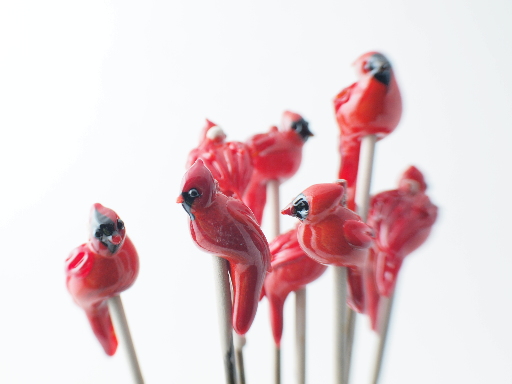This is basically the long-form set of destructions (huh) for glassact's December challenge. Everyone else is welcome to play along if they like, or go look for something more interesting if not:)[1]
Colors:
- red
- white
- green
- black
- grey
Use transparents or opaques. Metal color is silver.
Participation in the recent challenges has been poor (3 people for nov, 1—me—for oct) so I volunteered to do cardinals (subject to my hands/elbows behaving). Y'all will be happy to know I got three[2] done last night, so I think I'm good to go.
However,part of the problem is that people have no idea what to do with their designer beads, or don't like bracelets or already have a xmas bracelet —I have two, so I get it! So just mix things up a bit I thought I'd discuss making headpins/wire ended objects as part of this month's technique.
Candy, of course, has been making wonderful little glass ended headpins for these projects for years—hers were the first I saw, for the kwanzaa holiday exchange (about a decade ago). And of course, those of you who went to the synergy meeting at GLBG had a blast with Cyndy G's components, which included copper headpins with glass drops.
Susan Maytch-Hager has perhaps explored the possibilities the most, and had an absolutely gorgeous piece in progress at Winter Wonders, with lots of transparent, acid etched greys —part of the reason I wanted to add grey and black to our color scheme! Denise Billups-Walker is making focals using this technique as well. (And the original badass glass artisans of glass doodads on wire would of course be the father and son team of Leopold and Rudolph Blaschka.
Making fancy glass headpins has a long and honorable history, so let's discuss some approaches:)
Types of wire
- sterling (20 ga)
- 308 (20 ga)
- cheap annealed (16–18 ga)
Since some people do want to make bracelets, I'm gonna suggest silver/black wire—20 gauge sterling wire works well; or you can purchase heavy 2" headpins & build your bead on the end. For wire that short, you'll need to mount it in a pin vise or similar. Another option that I've used for years is spooled 20ga 308 wire—I purchased a 2# spool roughly 30 years (and quite by accident got the type of steel that is the same we use for mandrels!) which is very strong and springy, which means you can also use it to make your pin backs (which in fact is why I bought it...) You'll need a way to sharpen the point, though it's helpful to have a grinder, dremel or foredom for that step. Another inexpensive option is annealed black wire—it's much thicker and softer, so it has a heavier visual presence, and it's easier on your hands and tools. Be aware that it rusts, however.
Types of doodads to put on your wire:
- round
- pointed
- leaves
- pressed flowers
If ever you've been wanting an excuse to pop for a pair of cup shears—and the word on the street is that Jim Moore's are the best value (I've been pretty happy with my D2 cup shears—well, except for getting hit by a car the day after I ordered them, and not being able to put them to use!) If a $100 tool isn't in your budget, I've had folks report very good results with the $3 chinese big-handle scissors (though I've personally not had much luck with them). Other fun tools for shaping glass on the end of your wire include various tweezers and mashers (e.g. leaf vein mashers, pointed oval mashers, half round-link forming pliers, etc) Plus, of course those fancy Italian flower shapers several of our esteemed guild members have been sporting!
Use these tools to texture, cut (then twist/mash!), and mold glass to your heart's content. One fairly easy item would be a holly leaf: ball up your glass, mash to an lollipop, soften the entire thing, then use a self-colored rod (or tweezers) to pull into an oval. Some holly leaves are in fact oval, so you could call your project done right there, but if you want to add the serrations, heat just a small section of the leaf, then use the rod to pull it to a point. (Using a rod in my opinion is faster and easier than tweezers, because there's no glass to discard or need/worry to keep the tool cool.) For an even fancier, variegated holly leaf, put a band of white around your lollipop (round disk) before pulling it to points.
And simplest of all: berries. Personally, I think people tend to underestimate the need for simple fillers. Ball-ended wires sticking up out of compositions give a lot of ‘bang for the buck’ —easy to make, very lightweight, and yet dramatic. Or, you could play stripes and spots with round balls, then pull and twist them into cones/teardrop shapes.
Next question: how to make all this stuff into a pin, focal, or other non-wearable item. Now that we have a decent pool of people who have been playing with this sort of thing for awhile, perhaps we could have that as a meeting topic? (I have to say, I personally don't worry how I'm gonna use cool stuff. I'll figure something out eventually —even if it takes me 30–40 years...)
At any rate, I've got almost all the birdies done, folks, so light those torches & melt some glass!
Unless otherwise noted, text, image and objects depicted therein copyright 1996--present sylvus tarn.
Sylvus Tarn